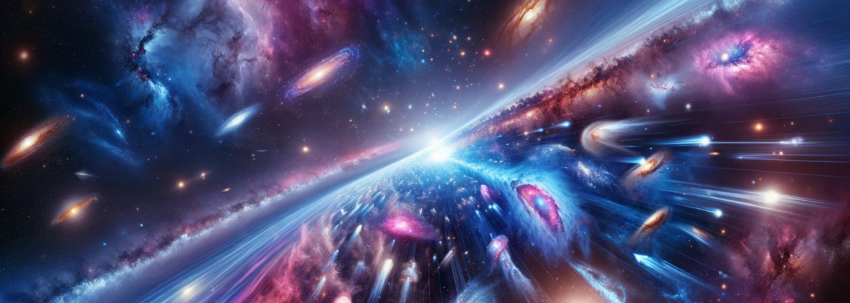| Listen to our audio presentation: The James Webb Space Telescope |
A revolution in our understanding of the universe may be on the horizon, thanks to groundbreaking research into quantum gravity. This novel theory seeks to merge the principles of quantum mechanics with Einstein’s general theory of relativity. A paper published recently in the journal Classical and Quantum Gravity posits that this integration, applied to the early universe’s expansion, could resolve a major cosmological puzzle known as the Hubble tension.
What is the Hubble Tension?
The Hubble tension is a discrepancy that has perplexed scientists for decades. It refers to differing measurements of the universe’s expansion rate, known as the Hubble parameter. These measurements are derived from two main sources: observations of distant cosmic objects and the cosmic microwave background, the Big Bang’s afterglow. The variance between the results challenges our current understanding of cosmic evolution.
The Pioneering Paper
The study, authored by physicists Anupama B. and P. K. Suresh from the University of Hyderabad, suggests incorporating quantum gravity effects during the cosmic inflation period could help solve the Hubble tension. They propose that quantum effects at this stage could produce a higher rate of change of the Hubble parameter, consistent with a wide range of observations, while also influencing the reheating temperature of the universe post-inflation.
“Our equation doesn’t need to account for everything, but it does not prevent us from testing quantum gravity or its effects experimentally,” says P.K. Suresh in an email interview with Live Science. These quantum effects include random field fluctuations and the spontaneous creation of particles from the vacuum of space—phenomena not accounted for in classical descriptions of the universe’s expansion.
The Historical Context
The universe’s expansion was first discovered by Edwin Hubble in 1929. His observations revealed that galaxies farther away are moving away faster, suggesting that the universe itself is expanding. Throughout the 20th century, scientists refined this measurement with newer techniques, particularly by studying the cosmic microwave background (CMB). However, this method resulted in a Hubble parameter almost 10% lower than what was deduced from direct astronomical observations.
The discrepancy, known as the Hubble tension, suggests potential flaws in our cosmic models. Enter quantum gravity. Despite its theoretical promise, quantum gravity has remained elusive. Unlike quantum mechanics, which revolutionized our understanding of small-scale physics, integrating quantum theory with general relativity has proved challenging.
The Role of Quantum Gravity
Quantum mechanics deals with nature on the smallest scales of energy, and general relativity explains gravitational forces at large scales. Thus, a theory of quantum gravity aims to reconcile these two, potentially providing a new framework for measuring the universe’s expansion.
The study by Suresh and Anupama focused on broad quantum-gravity effects common to many proposed theories, avoiding the need for precise calculations—an often insurmountable challenge due to the extreme scales and energies involved. Their findings indicate that quantum effects during cosmic inflation can realign the Hubble parameter measurements from different observational techniques.
Future Prospects
While the full theory of quantum gravity is yet to be formulated, Suresh insists that new methods to experimentally test quantum gravitational effects could be on the horizon. Measurements of the CMB properties, along with gravitational waves from the early universe, offer promising avenues.
“Some of the future missions devoted to studying this electromagnetic background are highly probable and promising to test quantum gravity,” Suresh added. Additionally, detecting primordial gravitational waves could further bolster the understanding of quantum gravitational phenomena, placing invaluable constraints on inflationary models and enriching our comprehension of the universe’s early dynamism.
Moreover, this research alludes to broader implications for other fields of study. Quantum gravity could significantly inform various domains, from quantum chemistry to quantum information science, by offering a unified framework for understanding both microscopic and cosmic scales.
Closing Thoughts
Quantum gravity stands as an exciting frontier in modern physics, holding the key to resolving longstanding cosmological conundrums like the Hubble tension. This signifies a profound push towards unifying the smallest and largest scales of our universe. In doing so, it not only refines our understanding of cosmic history but potentially paves the way for new technology and theoretical advancements across the board.
Information Box:
– Hubble tension: Discrepancy in the measurement of the universe’s expansion rate.
– Edwin Hubble discovered the universe’s expansion in 1929.
– Quantum gravity seeks to unite quantum mechanics with Einstein’s general theory of relativity.
– Cosmic microwave background: The residual heat from the Big Bang.
– Cosmic inflation: The rapid expansion of the universe immediately following the Big Bang.
– Planck 2018: Significant data set used to measure the Hubble parameter.
– Quantum effects: Include phenomena like field fluctuations and spontaneous particle creation.
References:
1. “A possible solution to the Hubble tension from quantum gravity” by Anupama B and P K Suresh, Classical and Quantum Gravity, Volume 41
2. “A new theory of quantum gravity could explain the biggest puzzle in cosmology, study suggests” by Andrey Feldman, Live Science
3. “Quantum mechanics: A foundational theory in physics” by Mark Williams, Digital News Report

